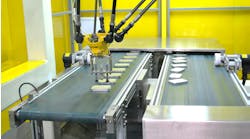One of the best parts of this job is getting to share great stories about how technology is applied. There’s a lot of focus on what product innovations will do in the future, and that’s important. Equally valuable is what those innovations are doing today to improve efficiency and productivity.
Under the headline “Electric Actuation Mixes Precision and Efficiency” is the story about how Festo and SKF worked on a joint venture to integrate electric actuation into an anti-corrosion spray for SKF’s roller bearings line. It’s one thing to talk about those concepts in abstract terms; it’s quite another to see them applied to real-world challenges.
One of the expected benefits of the application was energy savings, but to achieve that at the loss of efficiency or quality doesn’t provide value. As the article discusses, the key to any technology change is whether you gain more than you lose, and how long it might take to achieve that gain.
“Return on Investment” is one of the trickiest equations in all of manufacturing, because everyone views ROI from a different perspective. For the CFO, six months to ROI might be too long; for the operations manager, it might not be enough time to fully implement the change. In the real world, the words “Return” and “Investment” may as well be opposites. Return is almost always seen in the shortest time possible, whereas Investment is seen as a long-term commitment.
Yet both are vital. We need investments to improve our returns, and we need to loop those revenues back into further improvements. As it was in the case at SKF, the investment was seen through the lens of trying to improve one area of operation. The reality is that it improved other areas as the benefits were better understood and the operations team got a better sense of how to optimize the technology.
Continuous improvement doesn’t happen on a spreadsheet; neither is it a “feeling” about how something will perform. There’s enough data today to measure how technology is performing in our systems, and enough on-the-ground experience to turn that data into knowledge, and then into improvements that can be rolled out elsewhere in a plant.
As this case study demonstrates, the technology is only the first step to success. This project succeeded because engineers asked how things could improve and worked in tandem to turn technology into solutions. That investment in human capital is also hard to calculate, but the return almost always pays huge dividends.
And those are the best stories to tell.

